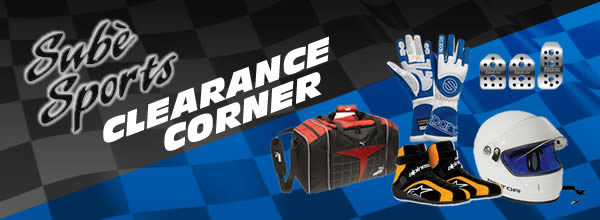Helmets at Sube Sports - Racing Equipment
Why Head Protection Matters
Speed, debris, and sudden impact are part of the sport.
The right helmet reduces risk and keeps attention on the next braking point.
Benefits at a Glance
- Impact control: Shell and liner spread energy from a hit.
- Heat and flame resistance: Interior materials resist ignition.
- Low fatigue: Light builds ease neck strain during long runs.
- Stable airflow: Shapes cut drag and wind roar.
- Clear vision: Wide eye-ports and quality shields aid awareness.
What to Look For
Choose safety first, then refine for fit and comfort.
- Certification: Snell SA2020 or FIA competition approval.
- Fit: Snug, even pressure; no hot spots or wobble.
- Weight: Carbon and advanced blends lower strain.
- Venting: Channels move air through crown and brow.
- Shields: Anti-fog coatings; tear-off compatibility.
- Prep: Radio or hydration ports if your series permits.
Quick History
Leather caps gave way to fiberglass in the 1950s.
Fire-resistant liners became standard in the 1970s.
Today’s shells use carbon, Kevlar, and tuned aerodynamics.
Materials and Construction
Shells and liners work together. Here’s how.
- Fiberglass: Durable and cost-effective for club events.
- Carbon fiber: Very light and very strong for long stints.
- Kevlar blends: Extra toughness without bulk.
- EPS liners: Multi-density foam manages different impact loads.
Inside, fire-safe fabrics, removable pads, and anti-microbial liners support hygiene.
Fit Guide (Fast Checklist)
- Measure head at the brow; compare to the brand’s chart.
- Try on with balaclava if you use one regularly.
- Cheek pads should be firm; the helmet should not rotate freely.
- Hold the shell and move your head—interior should grip evenly.
- Wear it for a few minutes; check for pressure points.
Accessories That Help
Small upgrades add comfort and safety.
- HANS device: Limits head travel during deceleration.
- Shields and visors: Clear, tinted, or mirrored for changing light.
- Comm kits: Reliable team radio in endurance stints.
- Helmet bag: Prevents scratches and UV exposure.
Rules and Approvals
Check your series bulletin before you buy.
- Snell SA2020: Common across North America.
- FIA 8859-2015: Accepted in many international categories.
- FIA 8860: Premium spec used in top-tier racing.
Using approved headgear speeds up tech inspection and keeps you eligible.
Common Mistakes
- Buying too large “for comfort.” It reduces protection.
- Skipping certification to save money.
- Ignoring weight and venting for hot climates.
- Cleaning with harsh chemicals that damage liners.
Care and Service Life
Plan on replacement every five to seven years.
Retire any helmet after a major impact or visible damage.
- Hand-wash pads with mild soap; air-dry only.
- Wipe shells with gentle cleaner; avoid solvents.
- Store cool and dry; keep out of direct sun.
- Transport in a padded bag to prevent knocks.
Who Needs This Gear
Track-day drivers, club racers, and pros all benefit.
Good head protection lowers risk and boosts focus at any level.
FAQs
Do I need a new model for each event? No. Use it until the approval expires or the helmet is damaged.
Is lighter always better? Lighter helps comfort, but fit and approval come first.
Can I use a bike helmet? Most series require SA or FIA ratings, not motorcycle-only standards.
Shop with Confidence
We stock Bell, Arai, Sparco, and OMP with current approvals.
From entry models to carbon builds, you’ll find safe, comfortable options for your series.
Get equipped and drive with confidence.









